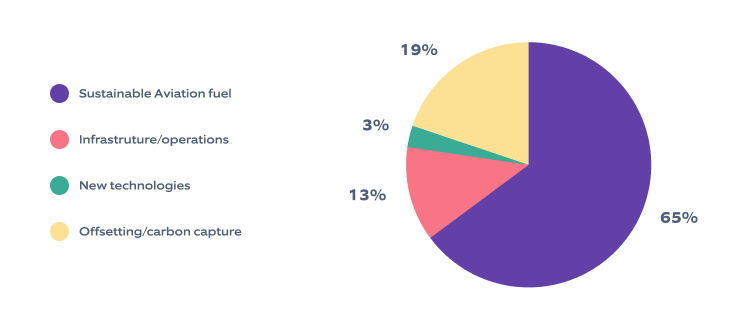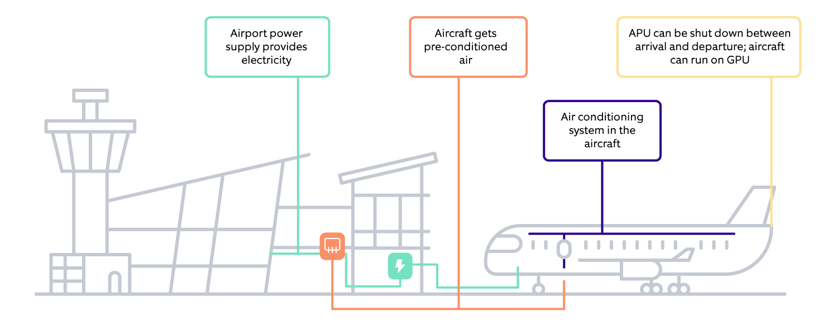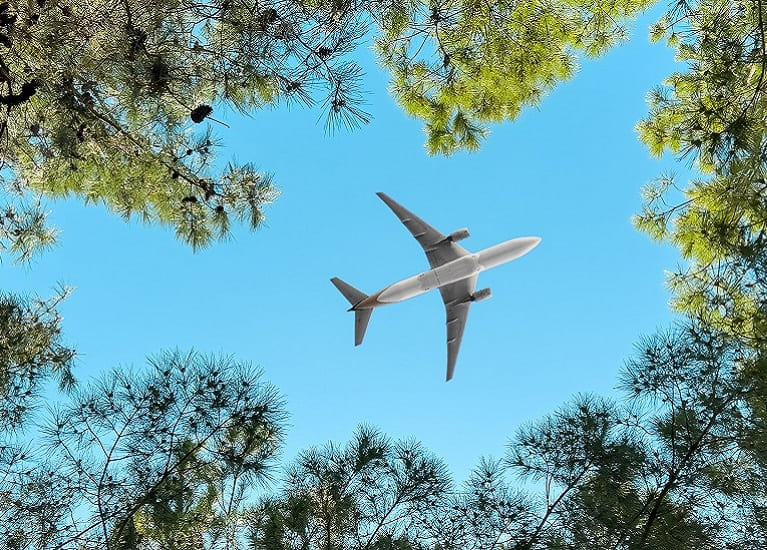The aviation industry connects people and countries, opening the gateway to many economic and social opportunities. Given the benefits aviation brings, the need for connectivity is growing. IATA estimates that the demand for air passenger journeys in 2050 could exceed 10 billion, and the expected carbon emissions between 2021 to 2050 will be approximately 21.2 gigatons of CO2. This vast amount of emissions will need to be mitigated! A resolution was passed by IATA member airlines committing to achieve net-zero carbon emissions by 2050.
Roadmap towards net zero
The major focus on achieving net zero carbon emissions is on using sustainable aviation fuel (SAF), investing in new aircraft technology, and carbon offsetting methodology. We believe that the 2050 objective can be accelerated by realigning the existing infrastructure & operations, which can contribute directly to reducing carbon footprints.

Figure 1: Contributors to achieving net zero carbon by 2050s (Source: IATA)
This article will discuss how airlines can optimize their current operational setups, making them more sustainable by introducing five potential schemes to improve operational efficiency, increase productivity, reduce OPEX, and deliver a strong customer experience.
1. Fuel-saving schemes
Reduce CO2 emissions from aircraft ground movements by overcoming long taxi-in and taxi-out times
Taxiing aircraft contribute significantly to fuel burn and emissions at airports. Taxiing delays are frequently caused by congestion and queuing, which occurs when there are last-minute changes in the departure sequences, gate allocation issues for arrival flights, delays in departing flights, etc. To overcome these challenges, airlines can deliver an on-time flight turnaround process. They can also update ATC and airport operators with accurately predicted off-block time (POBT) to plan runway and gate utilization effectively.
The single largest operational expense for airlines is fuel, which accounts for nearly 30-60% of expenditure in an average year.
Also, many airlines rely on the manual calculation of the EOBT (expected off-block time) and TOBT (targeted off-block times) for pushback timings. To overcome chances of error, airlines and airports can build a smart turnaround model that leverages technologies like computer vision and AI/ML. The model can associate each of the turnaround tasks with an object which can be visually identified from the camera stream at the airport.
In specifics, this may mean:
| Task | Object | The time when they are tracked |
| Aircraft arrival at the bay | Aircraft | The aircraft is stationary. |
| Passengers deboarding | Staircase/Aerobridge | Passengers are detected. |
| Baggage unloading | Baggage trollies | Both vehicles are near to each other and not moving. |
| Refueling | Fuel truck | A truck is near the aircraft, and the hose is attached. |
| GPU connected | GPU | GPU is close to the aircraft and not moving. |
Combining the real-time events with historical data and understanding of the airport, airline, and ground handlers, this model can evaluate the performance of the turnaround activities and utilize it to alert the stakeholders in case a process hasn't started or if a delay is expected. All this while continuously predicting POBT and helping ATC and airport operators optimize runway and gate utilization.
Reduce CO2 emissions in the air by upgrading flight plans with best practices
Data analytics can enable better decision-making, reduce carbon emissions, and improve flight efficiency. Data can be used to boost the flight plan with the best practices for the operating crew. Airlines can leverage AI/ML-based algorithms that analyze billions of data records from multiple data sources, including flight data recorders (FDR), operational flight plans, ACARS messages, engineering systems, load sheets, and tech logs, and combine them with real-time environmental data and actual flight conditions to identify the best practices for fuel saving.
Post-flight, the data from the Electronic flight folder (EFF) can be extracted, and a report can be generated. This will tell the amount of fuel that was saved during the flight, giving multidimensional insights to relevant stakeholders for necessary actions.
Reduce flight turnaround process time by digitalizing the refueling process
Today, if the cockpit crew makes a small change in refueling figures, it takes a long time to pass on the message to the refueling agent. Airlines still use a combination of paper-based transactions and outdated systems to manage their operations, which often adds extra minutes to the flight turnaround process. Digitizing this process can improve efficiency and increase transparency in many ways, leading to increased sustainability and reduced carbon footprint, with the bonus of saving time and money.
2. Air Quality Index improvement schemes
Reduce APU utilization at apron
APUs are small engines located in the aircraft tail and are used to power electrical systems onboard when the main engine is turned off. It can power cleaning equipment, run air conditioning systems, and even start main engines before or during pushback. The problem? APUs run on jet fuel with higher carbon emissions.
Aircrafts should transition to ground power units (GPUs) for their ground operations whenever possible. Airports and airlines can work on identifying the aircrafts that continue running on APUs at the gates, even when GPUs are available. Microphones positioned at gates can act as IoT sensors that pick up the sound of the APU running. This data can then be cross-referenced against schedules and other data to determine whether an aircraft is running its APU instead of using the power grid. Relevant stakeholders can then be informed, so necessary actions can be taken to improve air quality and reduce carbon emissions.
At the same time, airlines can also track the APU utilization from APU logs available in the cockpit, which provides data on-time units, cycle run, and even the average produced by APU engines. This information can further be mapped with respective flights, routes, and operating crews to understand when APU was overutilized. This solution on blockchain technology can help airlines build the APU lifecycle which can accurately report the carbon emission per APU.

Figure 2: Reducing airline APU utilization for sustainability (Source: Aviation Benefits)
3. Paperless operation schemes
Amplify human potential with digital skills
Even today, airlines' staff rely on paper-based transactions and manual tasks, which are often time-consuming and error-prone. Some of them, like flight dispatch documents and operating manuals, cannot be avoided as regulatory authorities lay them down. But there is a lot of scope among the other operating areas which can be digitalized.
Airlines must develop a new approach to amplify human potential with a blended workforce where human skills are complemented with digital skills. Depending upon the operational scale and workforce distribution, airlines can curate personas for specific roles that play a major role in the operation. Airlines can easily target roles like cabin crew, ramp agents, and engineering staff to start their journey. They depend on paperwork. You can empower them with a mobility solution that caters to all their needs starting from managing their roster in the morning to getting a cab and performing all their mundane tasks while also connected with all other airline systems. This solution will holistically cover their work lifecycle.
Overcome thermal bag tag and asset reconciliation challenges
During the pandemic, airlines and the airport accelerated their contactless journey by onboarding self-bag drop kiosks and home-printed bag tags. But, even then, more than 95% of baggage operations across the world depend on thermally printed bag tags which are extremely dangerous to the environment. When you consider the thermal paper's chemical composition, it contains Bisphenol A (BPA) and other phenolic chemicals that pose many risks to the environment and can't be easily recycled. The easy solution is to use digital bag tags, which can be reused by the passenger every time they travel. Digital bag tags are easy to reconcile and deliver a complete baggage journey view across various scan points.
Similarly, assets reconciliation challenges across various other functional areas like GSE, engineering, catering, and even aircraft safety equipment could be solved by using IoT technology. For instance, today, the reconciliation of lifesaving jackets installed under the aircraft seats is done manually by the security staff on paper. This can easily be transitioned to a one-click reconciliation using IoT.
4. Cabin waste management schemes
Airlines must focus on minimizing their cabin waste by reducing, reusing, and recycling to minimize their environmental footprint. Cabin waste comes from 2 main streams—cleaning waste and catering waste.
As per a study by IATA, 23% of the total waste generated per passenger consists of 'untouched food and drink'.
To overcome this challenge, airlines can leverage technologies like computer vision along with AI/ML for understanding travelers' likes and dislikes of a particular food item across different sectors and booking classes and on various routes. This data can help caterers understand the food consumption patterns, and revise the menus accordingly.
5. Facility usage optimization schemes
Another big challenge adding to airlines' carbon footprint comes from their facilities like back offices, training institutes, corporate offices, and even self-operated terminals.
Airlines can optimize their buildings' energy consumption by deploying IoT sensors on various assets in their facilities, including lighting, cooling systems, doors, and toilets, to track their energy utilization and automatically shut them down when not in use. Data from all these sensors can be brought together to create dashboards, delivering actionable insights that can help facility managers optimize energy consumption. This data can be further used to build predictive analysis to identify and replace dysfunctional equipment without creating bottlenecks and downtime at the facility.
While the airlines are doing the heavy lifting by bringing SAF and investing in new aircraft technologies, a lot can be done within the existing operational setup and reduce their carbon footprint.
We, at Nagarro, bring in the much-needed technological and domain capabilities to help airlines implement green schemes and embrace the challenge of sustainability. To know more about how we can support you in your net zero journey, contact our experts at explore.tnl@nagarro.com.





